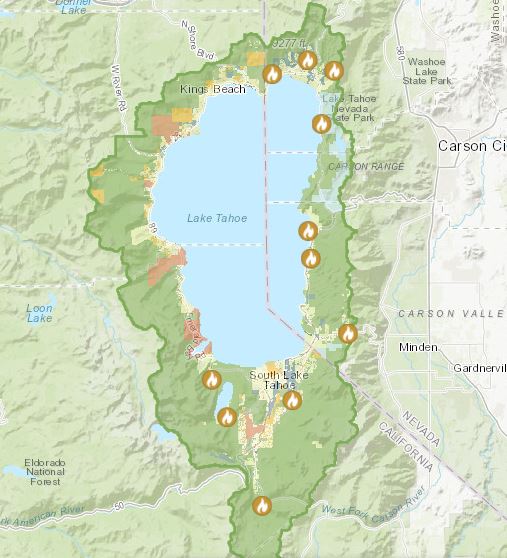Lake Tahoe Prescribed Fire Operations to Continue Conditions and Weather Permitting
Contact: USDA Forest Service, Lisa Herron 530-721-3898 or
LAKE TAHOE, Calif./Nev., Nov. 18, 2024 – The Tahoe Fire & Fuels Team (TFFT) Fall Prescribed Fire Program continues this week around Lake Tahoe, conditions and weather permitting. North Lake Tahoe Fire Protection District may burn piles around Incline Village, Tahoe Douglas Fire Protection District may burn piles near Glenbrook, Logan Creek and on Kingsbury Grade, and the USDA Forest Service Lake Tahoe Basin Management Unit may burn piles off Luther Pass near the campground and off Fallen Leaf and Spring Creek roads near South Lake Tahoe.
Smoke will be present and is expected to travel in a north, northeast direction. View helpful Smoke Management Tips and the current air quality index at AirNow and the U.S. Environmental Protection Agency/USDA Forest Service Fire and Smoke Map. View the prescribed fire map with project details at Tahoe Living With Fire. To be added to the prescribed fire notification list,
Prescribed fires are a vital forest management tool used by land managers to help protect communities by removing fuels that can feed unwanted wildland fires. Burning excess vegetation also benefits forest health by making room for new growth which provides forage for wildlife, recycling nutrients back into the soil and reducing the spread of insects and disease.
Prescribed fire managers use different methods to remove excess vegetation (fuels) and reintroduce low-intensity fire into forests through pile, broadcast, and understory burning. Pile burning involves burning slash piles that are constructed by hand or mechanical equipment. Broadcast and understory burning use low-intensity fire to remove fuels under specific environmental conditions with fire confined to a predetermined area.
Historically, low-intensity wildfires ignited by lightning or native peoples routinely burned through fire-adapted ecosystems of the Sierra Nevada. These low-intensity fires burned at low temperatures and moved slowly across the ground removing forest debris such as pinecones, needles, limbs, dead and downed trees, and ladder fuels. Watch the Forest Service video for an in-depth explanation of low-intensity fire. Prescribed fires are intended to mimic these naturally occurring low-intensity fires that are essential to fire-adapted ecosystems.
Prescribed fires may take place any time of year when conditions are favorable. Fall typically brings cooler temperatures and precipitation, which are ideal for conducting prescribed fire operations. Each operation follows a specialized burn plan, which considers smoke dispersal conditions, temperature, humidity, wind, and vegetation moisture. All this information is used to decide when and where to burn.
The TFFT strongly supports the use of prescribed fire under appropriate conditions and works closely with air quality districts to avert smoke impacts on the public. Smoke from prescribed fires is normal and may continue for several days after an ignition depending on the project size, conditions, and weather. Prescribed fire smoke is generally less intense and of much shorter duration than smoke produced by unwanted wildfires. Smoke from prescribed burns, wildfire or wood burning stoves may hang low to the ground at night and in the early morning due to a phenomenon known as a temperature inversion. A temperature inversion is when warm air “caps” cooler air, causing smoke to become trapped in valley bottoms at night and in the early morning.
Prior to prescribed fire ignitions, agencies coordinate closely with local and state air quality agencies to monitor weather for favorable conditions that will disperse smoke, conduct test burns before igniting larger areas to verify how well vegetation is consumed and how smoke rises and disperses before proceeding, post signs on roadways in areas affected by prescribed fire operations, email notifications to the prescribed fire notification list, and update the local fire information line at 530-543-2816. The TFFT gives as much advance notice as possible before burning, but some operations may be conducted on short notice due to the small window of opportunity for implementing these projects.
Learn more about living in fire-adapted ecosystems, prescribed fire and fuels reduction at Tahoe Living With Fire and get prepared, get informed, and get involved!
###
